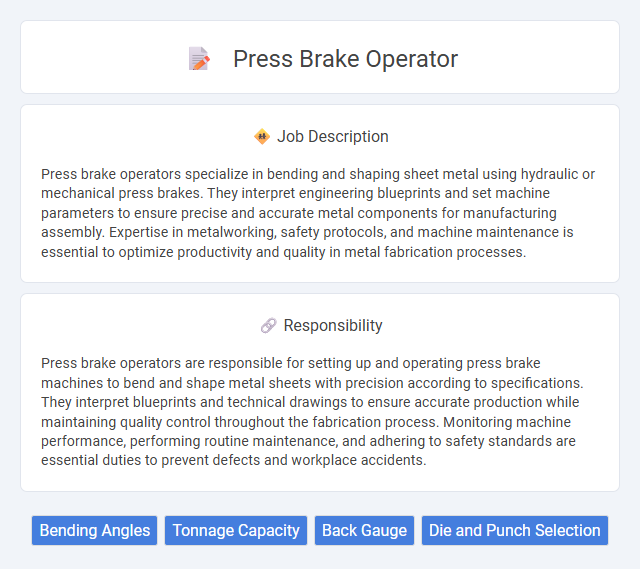
Press brake operators specialize in bending and shaping sheet metal using hydraulic or mechanical press brakes. They interpret engineering blueprints and set machine parameters to ensure precise and accurate metal components for manufacturing assembly. Expertise in metalworking, safety protocols, and machine maintenance is essential to optimize productivity and quality in metal fabrication processes.
Individuals with good hand-eye coordination and mechanical aptitude are likely suitable for a press brake operator position. People who can remain focused, handle repetitive tasks, and adhere to safety protocols may have a higher probability of thriving in this role. Physical stamina could also be important given the demands of operating machinery and handling heavy materials.
Qualification
A Press Brake Operator typically requires a high school diploma or equivalent, with specialized training in press brake machine operation and metal fabrication techniques. Proficiency in reading blueprints, interpreting technical drawings, and knowledge of CNC programming enhances job performance and employability. Strong mechanical aptitude, attention to detail, and safety awareness are essential qualifications for ensuring precise bending and shaping of metal components.
Responsibility
Press brake operators are responsible for setting up and operating press brake machines to bend and shape metal sheets with precision according to specifications. They interpret blueprints and technical drawings to ensure accurate production while maintaining quality control throughout the fabrication process. Monitoring machine performance, performing routine maintenance, and adhering to safety standards are essential duties to prevent defects and workplace accidents.
Benefit
Press brake operator jobs may offer the benefit of gaining specialized skills in metal fabrication, enhancing employability in manufacturing industries. There is a probability of earning competitive wages with potential overtime pay due to the skilled nature of the work. Employees might also experience job stability and opportunities for advancement within companies that rely on precision metal bending processes.
Challenge
The role of a press brake operator likely involves managing precise metal bending tasks, which requires a strong attention to detail and the ability to interpret complex blueprints accurately. Challenges may arise in maintaining consistent quality while working with varying material thicknesses and types, demanding quick problem-solving skills and adaptability. Operators probably face time constraints that necessitate efficient machine setup and operation to meet production deadlines without compromising safety.
Career Advancement
A press brake operator develops expertise in metal fabrication by mastering precision bending techniques and machine setup, paving the way for roles such as CNC programmer or production supervisor. Gaining certifications in computer numerical control (CNC) and advanced machinery operation enhances career prospects and salary potential. Continuous skill development in automation and quality control positions press brake operators for leadership roles within manufacturing and engineering sectors.
Key Terms
Bending Angles
Press brake operators specialize in precisely bending metal sheets by adjusting bending angles to meet exact specifications. Mastery of angle calibration and control is crucial for producing components with correct tolerances and structural integrity. Their expertise ensures accurate repeatability in manufacturing processes requiring various bending angles.
Tonnage Capacity
Press brake operators manage machines that bend sheet metal, with tonnage capacity indicating the maximum force the press brake can exert, often ranging from 20 to over 300 tons. Choosing the correct tonnage capacity is critical for precision and metal thickness, as insufficient tonnage may result in incomplete bends or machine damage. Expertise in tonnage capacity ensures efficient operation, minimizing material waste and optimizing manufacturing workflows.
Back Gauge
The Back Gauge is a critical component in press brake operations, ensuring precise metal bending by positioning the workpiece accurately against the machine's ram. Press brake operators rely on programmable Back Gauges to achieve consistent angle and length specifications, increasing production efficiency and reducing material waste. Mastery of Back Gauge settings and calibration is essential for maintaining tight tolerances and meeting complex fabrication requirements.
Die and Punch Selection
Press brake operators play a crucial role in manufacturing by selecting the appropriate die and punch to match the metal thickness, material type, and desired bend angle, ensuring precision and quality in bending operations. They must understand the relationship between die width, punch geometry, and bend radius to prevent material damage and achieve consistent results. Proper die and punch selection directly impacts efficiency, reduces machine wear, and improves product durability in sheet metal fabrication.
 kuljobs.com
kuljobs.com